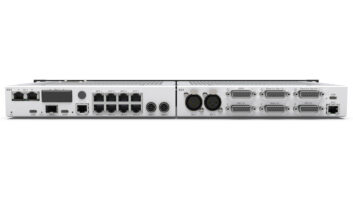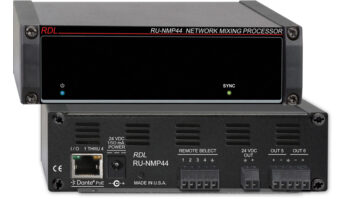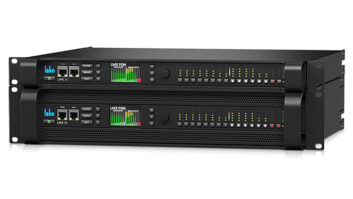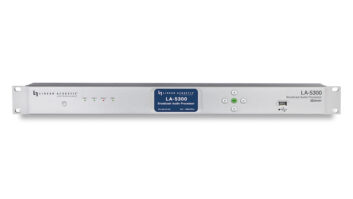Kurzweil’s KSP8 is more than just the sum of its 249 DSP algorithms and over 600 effects presets. This multibus signal processor offers flexible signal routing, configurable I/O, SmartMedia™ data storage, multistage metering and real-time control. More importantly, for those of us who work with surround audio formats, the KSP8 includes algorithms for 5.1 ambience, reverb and multiband compression. If you want to take full advantage of the level-controlled, multichannel panners and real-time Quick control parameters, then you’ll need to acquire the companion RSP8 remote with its joystick and eight Quick control knobs. Add to these the HUB7 multiport hub repeater, and you can fly seven KSP8s at once.
The two-rackspace KSP8 comes with four analog TRS balanced inputs, four TRS balanced outputs, a stereo AES/EBU I/O pair, a remote jack for the RSP8 or HUB7 and MIDI In/Out/Thru. It supports 44.1- and 48kHz sample rates with 24-bit precision, and it can slave to an external clock via the onboard AES/EBU pair or BNC connector for wordclock sync on additional hardware cards.
Via optional hardware cards, users can have as many as 22 “hard” inputs and outputs, though KSP8’s 8-bus architecture requires that you select eight or fewer inputs to process. The KANA4 card adds four more analog I/O channels. If you choose the KADT8 instead, you can add eight channels of Lightpipe and eight channels of TDIF. Although only eight channels may be chosen for processing at a time, outputs are always active, so this card doubles as a format converter. Digital I/O cards have BNC connectors for wordclock sync.
The KAES8 adds eight channels of AES/EBU I/O. It’s important to connect all of the input ports, and all inputs must be synchronous for outputs to work correctly. If you’re only processing signal from inputs one and two to 5.1 outputs, you must still have all inputs patched, but you can turn off the inputs internally using input select on the Config page.
The KSP8 is not just a 5.1 processor. Thanks to its bus architecture, it could also be used to provide eight mono (or four stereo effects) or 5.1 plus two mono programs, etc.
In the future, Kurzweil plans to offer an mLAN™ option for simultaneous audio and MIDI transmission over FireWire. It was not available at the time of this review.
THE BASICS
If you’ve ever played a Kurzweil K2000/K2500/K2600, then you’ll feel right at home with the KSP8’s 240×64 CCFL backlit display, soft buttons, scroll knob and data-entry keyboard.
The KSP8 boots into the Studio page the first time it’s used. Later, it remembers whether you were on the Studio page, FXBus or Quick mode page when you powered-down the unit.
The Studio is the highest-level object in the KSP8. It’s a snapshot of physical-connection settings, signal routing and levels (including analog and digital I/O selections). The Studio object also contains the assigned effects presets, effects chains, effect bus assignments, all MIDI channel and controller settings and multiband equalizer settings. With 999 locations for user-created objects, you can recall studio setups for many different projects.
The Master page includes the few para-meters that are not included in Studio objects: Studio Channel (MIDI channel for MIDI control of Studio MODs, program changes and controller messages); I/O Config (studio or master); Clock Source; DigWordLen (16, 20 or 24-bit on the digital output options); Dither (flat/triangular, or minimum, medium or maximum noise-shaping); DigFormat (AES/EBU or S/PDIF); and SysEx ID. These settings are saved separately from the Studio in the Master table. In order to completely recall a project, you’ll need to save both a Studio object and a Master table, and load both for the project.
To the left of the Studio list in the display panel for the Studio page is the SID, or Studio Information Display, a graphic representation of the amount of processing power being used on each bus. Processing power is also calculated in Processor Allocation Units (Us). Simple algorithms may use only one U; more complex and powerful algorithms for surround processing may use 12 or more. There are 16 Us available for each KSP8, so keep that in mind when you want to chain effects. The KSP8 Algorithm Reference Guide documents each algorithm, including its usage of Us. It’s available for download at www.kurzweilmusicsystems.com.
Other objects in the KSP8 architecture include chains, presets and algorithms. Studios, chains and presets may all be edited. An effect algorithm is a specific type of DSP processing (e.g., flange, reverb or distortion), which resides in ROM and may not be edited. You may, however, change the values of an algorithm’s para-meters and store those in a preset. Presets may be used alone on a bus in a studio or in series in a chain. A chain includes presets, quick parameters and MODs, with up to eight presets per bus.
REAL-TIME CONTROLLERS
MODs and Quicks allow for real-time MIDI control over the values of selected KPS8 parameters. MODs are modulators used to change parameter values in real time. Available in the Chain editor, Chain MODS (or C MODs) modulate effects parameters in a chain, allowing the most extensive real-time control of KSP8 effects; their parameters and settings are saved as part of a chain object. Studio MODs (S MODs) control the gain, frequency and level values of sends, EQs and outputs, but they do not control effect parameters. Parameters and settings for S MODs are saved as part of a Studio object.
Quick parameters, or Quicks, allow you to change up to eight of a preset’s para-meter values without changing the preset itself. Each algorithm has Quick parameters that have been chosen to be the most useful within each algorithm. The user can change these parameters and save them. If you have an RPS8 remote control, then these eight parameters are controlled by eight knobs on the remote. Like MODs, Quicks may be either Studio or Chain, and the parameters and their settings are saved with Studio or Chain objects. We noticed that when using Quicks, the granularity of the Quick knobs caused some changes to be far too rapid to be useful. In such cases, using the alpha wheel or the “jump” (nudge) buttons under the alpha wheel was more precise.
LFOs (low-frequency oscillators) are control sources that can be programmed on the Studio or Chain LFO pages. You can set upper and lower limits of each LFO’s rate, rate-control source, LFO shape and LFO start phase. There are 26 different LFO shapes that range from sine to positive 12-step.
ASRs (attack, sustain, release) are three-section unipolar envelopes that can be triggered by programmable control sources and can be delayed. You can use them to ramp the pitch or amplitude in a vibrato or tremolo, while enabling delays in those effects.
If you have ever played with a K2000 or later keyboard or sound module, then you’ll remember FUNs (the abbreviation for “Function”). If you set up a FUN as a control source, then you can mix the signals of two control sources and perform one of 50 functions on the combined signals, thereby generating a new control source value.
Fortunately, with over 600 effects presets, you won’t have to delve deeply into programming the KSP8 unless you want to. For those who need ultimate control, however, the infrastructure is there just beneath the surface.
SIGNAL PATH
Signal travels from hard inputs on the back panel to input select, EQ section, FX sends, FX buses, mix sends and buses, output select and finally back to the hard outputs on the back panel. There are three patch points: Pre-FX patch points between FX sends and FX buses; Post-FX patch points between FX buses and mix sends and buses; and Mix patch points between mix sends and buses, and output select.
Up to two types of EQ functions can be configured in series on each EQ bus. The FX send page has special 5.1-panning options. You can specify two different ways of panning in the front: LCR, which pans through the center channel, and L-R, which pans from left to right, leaving the center channel unchanged. Angle can be specified relative to the front-center speaker. You can also choose the radius (distance from the center of the room). With mix sends, you can route signals coming out of the FX section and use the mix buses to create a submix of the various FX buses before outputting them from the KSP8.
Using FX sends and mix sends, you can set up a “faderless” mixer. Add a set of MIDI faders and a SmartMedia™ card, and the KSP8 becomes an 8-channel digital mixer with a massive repertoire of effects setups.
AND IT SOUNDS GREAT, TOO
We loved the various reverbs and delays for 5.1 effects. Our favorite crazy effect for horror films was setting up scary noises and putting them through preset 798, Relay Delay. Setting up the panner was painless, too. Punch-up EQ/sends, then FX send. Select the Panner button next to the joystick on the RSP8 and crank the FX to FX1-6 R-Theta. You can set the front so that the panner skips the center channel, leaving the screams of the terrified teenager piercing and pure.
We were also pleased with the sound of the 24-bit, 128x oversampling A/Ds and D/A. For 96kHz and 192kHz sessions, we wouldn’t hesitate to pull the AES/EBU card out and go with the analog I/O card.
One invaluable feature is the multistage metering: input, pre-FX, post-FX and output. We could track down the source of distortion much more quickly than with typical FX boxes.
Another feature worthy of praise is the choice in Mix mode of insert (where mix control is set to a good starting point for a wet/dry mix), or send/return if you are using the device on a console send/return (100% wet). The Insert mode makes it easy to audition effects without worrying too much about resulting levels.
Storing data on a SmartMedia card seemed a scary proposition at first: We were afraid that we’d break the little wafer. However, when we realized how inexpensive the cards and outboard card readers were, we warmed right up to the little dears. Updating OS versions and making backups of KSP8 data was lightning-fast.
Carrying a base price of $2,995 (the optional RSP8 remote is $595; the KANA4, KADT8 and KAES8 I/O expansion cards are extra), Kurzweil’s KSP8 is an amazing box, immediately accessible with a vast network of controls and effects. It’s a tweaker’s dream, with real-time controls that are robust enough for any live show. The more we played with the KSP8, the more we felt that it belonged in our mix room, so we opened up a couple of spaces in the Lexicon/Eventide rack and added our fourth remote to the mixing desk. This one’s a keeper.
Kurzweil Music Systems/AND Music, 9501 Lakewood Drive S.W., Suite D, Lakewood, WA 99995; 253/589-3200; www.kurzweilmusicsystems.com.
Composer/engineer/producer K.K. Proffitt is the co-owner of Jam Sync, a surround production/mixing facility on Nashville’s famed Music Row.




